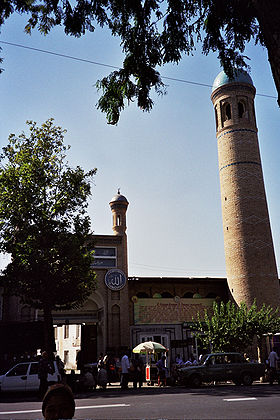Margilan
Margilan
Marg‘ilon / Марғилон | |
|---|---|
Khonakhan Mosque and City Center aerial photo | |
| Coordinates: 40°28′16″N 71°43′29″E / 40.47111°N 71.72472°E | |
| Country | |
| Region | Fergana Region |
| Area | |
• Total | 40.83 km2 (15.76 sq mi) |
| Elevation | 487 m (1,598 ft) |
| Population (2022)[1] | |
• Total | 242,500 |
| • Density | 5,900/km2 (15,000/sq mi) |
| Postal code | 151100 |
| Area code | (+998) 73 |
| Website | www |
 | |
Margilan (Template:Lang-uz, pronounced [marʁɨlɒn]; Template:Lang-ru) is a city (2022 pop. 242,500) in eastern Uzbekistan's Fergana Region.
Margilan is located in the south of the Fergana Valley, where trade caravans from China traveled westwards and vice versa during the days of the Silk Road. Margilan has been renowned for its silk goods as far back as the 10th century.[1][2]
According to legend, Margilan was founded by Alexander the Great. While stopping for lunch there, he was given chicken (murgh; in Template:Lang-fa) and bread (nan; in Persian: نان), from which the town took its name. More reliable records indicate that by the 9th century Margilan was an important stop on the Silk Road, along the route going across the Alay Mountains to Kashgar.
In the early 16th century Babur, the founder of the Mughal dynasty, mentioned that "the pomegranates and apricots are superb .... the game in Margilan is good; white deer may be found nearby. The people are Sarts. They are a feisty people, ready with their fists. The custom of exorcism is widespread throughout Transoxiana, and most of the renowned exorcists of Samarkand and Bukhara are Margilanis. The author of the Hidaya (Burhan al-Din al-Marghinani) was from a Margilan village called Rishtan".[3] This reputation for toughness extends to modern times. Margilan merchants were key players in Central Asian commerce, and were said to be a law unto themselves during Soviet days, when the city was the heart of Uzbekistan's black market.[citation needed] Margilan today is also a stronghold of conservative Islam, as is much of the Fergana Valley.
Economy
Uzbekistan's largest traditional silk factory, the Yodgorlik Silk Factory, is based in Margilan. It employs more than 2,000 workers and produces an annual output of 250,000 square meters of silk cloth. The neighboring Margilan Silk Factory employs 15,000 workers using modern machinery, and produces some 22 million square meters per year.
Main sites


Yodgorlik Silk Factory
Established in 1983 in an attempt to preserve traditional silk weaving techniques in the face of industrialisation, the Yodgorlik Silk Factory focuses on producing high quality handmade goods. It employs over 200 workers, and the full production process takes place in the factory, from the feeding of silk worms with mulberry leaves, to dyeing the silks with natural mineral and vegetable dyes, to weaving the silk. The factory is open to the public for guided tours, enabling tourists to learn about Margilan’s traditional silk weaving industry.[4]
Margilan Silk Factory
Margilan Silk Factory is a huge, state-run facility for industrial silk production. At its peak, it employed 15,000 workers, who produced up to 22 million square metres of silk each year.[4] It is still possible to visit.[5]
The Kumtepa Bazaar
The Kumtepa Bazaar is one of the most vibrant markets in Central Asia. It takes place on Sundays and Thursdays in a location 5 kilometers west of the city centre, and offers textiles, fresh produce, and household goods.[4]
Toron Mosque
Toron Mosque is just north of Margilan's Central Bazaar. It was founded in the 19th century by Said Akhmad Khodjaev, a wealthy philanthropist and advisor to the tsarist administration who later fled to Margilan during the Bolshevik Revolution.[4] In the 20th century, the building was used as a jail and then became an office. It now houses the Margilan Crafts Development Centre, which preserves traditional atlas and adras textile-making technologies.[6]
Khonakhan Mosque
The Khonakhan Mosque (also known as the Khonaqoh Mosque) was built in the 16th century and has been renovated by the Ministry of Culture. The mosque has two impressive minarets, each 26 meters high, and original carved wooden pillars made from cedar by master craftsmen in Margilan.[4]


See also
References
- ^ "Hududlar bo'yicha shahar va qishloq aholisi soni" [Urban and rural population by district] (PDF) (in Uzbek). Fergana regional department of statistics.
- ^ "Margilan, Uzbekistan". Retrieved February 3, 2021.
- ^ The Babur-nama Trans. & Ed. Wheeler M. Thackston (New York) 2002 p5
- ^ a b c d e Ibbotson, Sophie (2020). Uzbekistan. United Kingdom: Bradt Guides Ltd. pp. 149–150. ISBN 9-781784-771089.
- ^ "Margilan Travel Guide". Caravanistan. Retrieved 2021-04-20.
- ^ "UNESCO - Margilan Crafts Development Centre, safeguarding of the atlas and adras making traditional technologies". ich.unesco.org. Retrieved 2020-11-01.





